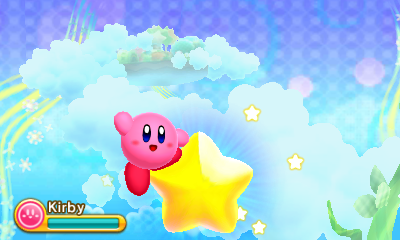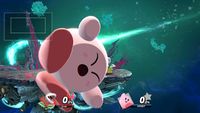Fourth wall: Difference between revisions
m (→General) |
No edit summary |
||
| Line 28: | Line 28: | ||
===''Super Smash Bros.'' series=== | ===''Super Smash Bros.'' series=== | ||
[[File:SSBU screen KO.jpg|right|thumb|200px|[[Kirby]] is Screen KO'd by [[mariowiki:Piranha Plant|Piranha Plant]] in ''[[Super Smash Bros. Ultimate]]''.]] | |||
{{SmashWiki|Screen KO}} | {{SmashWiki|Screen KO}} | ||
Starting with ''[[Super Smash Bros. Melee]]'', the games in the [[Super Smash Bros. (series)|''Super Smash Bros.'' series]] allow fighters who are launched beyond the top blast zone to occasionally splat briefly against the screen in a process called a [[smashwiki:Screen KO|Screen KO]]. The exact mechanics of this process differ between each game. | Starting with ''[[Super Smash Bros. Melee]]'', the games in the [[Super Smash Bros. (series)|''Super Smash Bros.'' series]] allow fighters who are launched beyond the top blast zone to occasionally splat briefly against the screen in a process called a [[smashwiki:Screen KO|Screen KO]]. The exact mechanics of this process differ between each game. | ||
[[Category:Gameplay Mechanics]] | [[Category:Gameplay Mechanics]] | ||
Revision as of 14:15, 21 October 2019

The term Fourth Wall is used to describe the separation of the audience from a performance. It is originally derived from stage play, where an imaginary fourth wall is said to separate the audience from the characters being portrayed, though it need not be a literal wall. This wall is meant to exist in the context of the story, which means that if actors look beyond the wall at the audience, whether intentionally or not, they are said to be 'breaking the fourth wall', thus breaking the illusion of a self-contained story. This can be pushed further by having actors directly address or interact with the audience, which is usually done for comedic effect or satire. Another means of breaking the fourth wall includes having the actors acknowledge their status as fictional characters, interacting with a narrator, or tampering with stage elements not meant to be interacted with such as backgrounds, cameras, or in the case of video games, the user interface. Breaking the fourth wall is particularly common in children's media, often as a method to engage the children with the characters in question.
Examples in the Kirby series
The Kirby series breaks the fourth wall on many occasions, though it is important to distinguish the difference between interactions in menus and instruction manuals and those in actual gameplay. The former cases are understood to take place outside of the context of the proper story, and as such are not canon. This article will only focus on examples of the fourth wall being broken in gameplay or in-game cut-scenes.
General
One common way that video games in general will break the fourth wall is to treat the display screen as a physical barrier within the game, or at least as a camera. The Kirby series does this on several occasions by flinging its characters into the "screen" for a more dramatic defeat. In such cases, the screen is often assumed to be a glass window.
In many games in the series, Kirby will wave at or otherwise acknowledge the player during certain moments. The first example of this is the ending of Kirby's Dream Land, where Kirby hoists up a sign in the very last cut-scene saying 'bye-bye'. This tradition carries on through most games in the series, with the ending of Kirby Star Allies having Kirby and any of his present friends waving at the player as they fly away.
In several games, particularly later ones, symbolic objects such as Doors and goal doors are directly interacted with as objects in the environment. This is particularly prevalent in Kirby: Triple Deluxe and Kirby: Planet Robobot.
Kirby's Dream Land
While the game is paused, Kirby will start dancing in place if left alone for long enough. This example is particularly notable as nothing is meant to move during a pause session.
Kirby Air Ride
While Kirby is riding an Air Ride Machine, he will acknowledge the player in a number of different ways. When left to coast forward for an extended period of time, Kirby will look back and motion for the player to make an input. When performing a smooth landing after a glide, Kirby will turn and pose ecstatically.
Kirby: Triple Deluxe
In this title, it is possible for Kirby to be knocked into and splat against the fourth wall directly whenever hit by a large object moving in toward the player.
On two separate occasions, when Kirby uses the Hypernova ability to defeat Flowery Woods and Queen Sectonia, their Stamina bars are ripped from the user interface and fly into Kirby's mouth.
Kirby: Planet Robobot
This game continues the gimmick from Triple Deluxe where Kirby can be knocked into the screen by certain obstacles. When he is piloting the Robobot Armor, he will leave a temporary crack in the screen when he hits.
Super Smash Bros. series
Starting with Super Smash Bros. Melee, the games in the Super Smash Bros. series allow fighters who are launched beyond the top blast zone to occasionally splat briefly against the screen in a process called a Screen KO. The exact mechanics of this process differ between each game.
